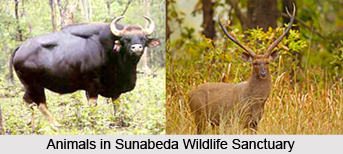Sunabeda Wildlife Sanctuary is one of the popular wildlife sanctuaries situated in the Indian state of Orissa. It is a proposed Tiger Reserve that is located in the newly constructed Nuapada District close to the boundary of Chhatisgarh state on the western fringe of Orissa. The forests of the region envelop the Nato hills and the Sukhupata hills also integrating with the Simlipal Tiger Reserve. The Sunabeda Wildlife Sanctuary is home to rare species of animals and plants.
Flora and Faun of Sunabeda Wildlife Sanctuary
The Sunabeda Wildlife Sanctuary spread over a sprawling area of 600 sq kms. The sanctuary is an ideal habitat for the Barasingha. It was declared as a Sanctuary in the year1983 and houses Tigers, Leopards, Hyena, Barking Deer, Chital, Gaur, Sambar, Sloth Bear, Hill Myna, Pea Fowl, Partridge, Elephant, Bison, Giant Squirrels and many other animals. The perennial streams that water the forests are home to a variety of reptiles and birds like Hill Myna, Peafowl, Partridge, Snakes and lizards.
 The Sunabeda Wildlife Sanctuary is also rich in vegetation. Plants like Bija (Pterocarpus marsupium), Teak(Tectona grandis), Sisoo (Dalbergia latifolia), Asan (Terminalia tomentosa), Dharua (Anogeisus latofolia), Mahul (Madhuca indica), Char (Buchnania lanzan), Mundi (Mitragyna parviflora), Kumbhi (Carreya arborea), Moi (Lannea coromondelica), Haldu (Adina cordifolia), Bahada (Terminalia bellerica), Harida (Termialia chebula), Amla (Emblica officinalis), Sandal wood (Santalum album), Sidha (Lagestroemia parviflora), Arjuna (Terminalia arjuna), Ban-khajur (phoenix acaulias) grow here that also provide shelter to animals.
The Sunabeda Wildlife Sanctuary is also rich in vegetation. Plants like Bija (Pterocarpus marsupium), Teak(Tectona grandis), Sisoo (Dalbergia latifolia), Asan (Terminalia tomentosa), Dharua (Anogeisus latofolia), Mahul (Madhuca indica), Char (Buchnania lanzan), Mundi (Mitragyna parviflora), Kumbhi (Carreya arborea), Moi (Lannea coromondelica), Haldu (Adina cordifolia), Bahada (Terminalia bellerica), Harida (Termialia chebula), Amla (Emblica officinalis), Sandal wood (Santalum album), Sidha (Lagestroemia parviflora), Arjuna (Terminalia arjuna), Ban-khajur (phoenix acaulias) grow here that also provide shelter to animals.
Sunabeda Wildlife Sanctuary is a grass covered plateau adjoining Udanti and Sitanadi Sanctuaries of Chhatisgarh State. This sanctuary also works as a migration link for rare wild Buffaloes between the states of Orissa and Chhattisgarh. Its also is a part of the tourist route linking Nrushinghanath, Harishakar, Patal Ganga, Patora Reservoir and Jogeswar Temple.
Apart from these eleven magnificent waterfalls, mystic caves at Ranimuhas, impressive archaeological sites at Giribaman, the firm fort of Jumlagarh and the bird observation points at Jalki and Raital Bandh in Maraguda are few of the major attraction for the tourists visiting this sanctuary. Godhus water fall flown down from a height of 30mtr. During the rainy season as well as in the winter season the fall is seen in its full flow but it gets dried up in summer. Down below the sanctuary a temple of Lord Shiva is present.
The best time to visit this Sunabeda Wildlife Sanctuary is during the month of October to February.











